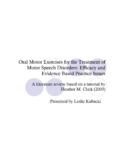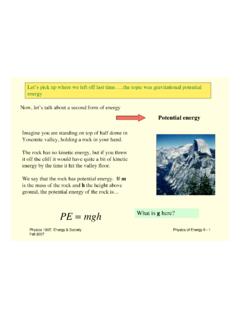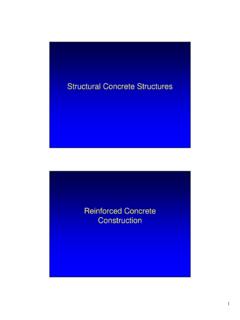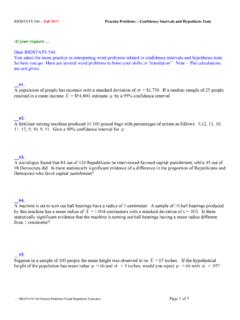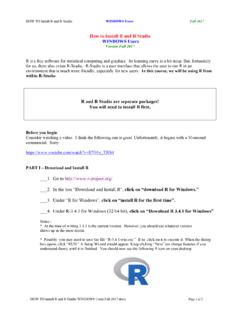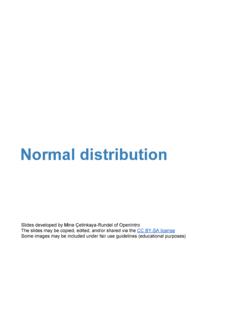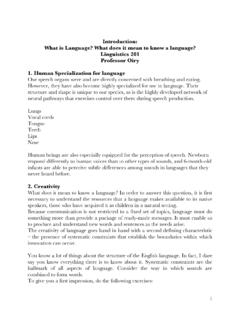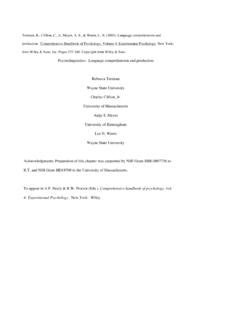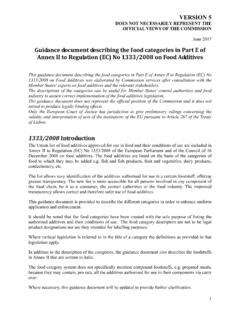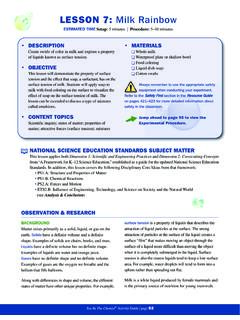Transcription of Emulsion Processing - Homogenization - UMass
1 Emulsion Processing - Homogenization -Jochen Weiss* food Structure and Functionality LaboratoriesDepartment of food Science & BiotechnologyUniversity of HohenheimGarbenstrasse 21, 70599 Stuttgart, GermanyEmulsion WorkshopNovember 13-14th, 2008, Amherst, MA1 Principle of Emulsion FormationOilWaterPrimaryHomogenizationSe condaryHomogenizationPremix2 Emulsion Processing :HomogenizersOilWaterHomogeniz erHomogenization is a unit operation using a class of Processing equipment referred to as homogenizersthat are geared towards reducing the size of droplets in liquid-liquid dispersions3 Physiochemical Processes Occurring During HomogenizationRapid adsorption:Stable dropletsSlow adsorption:CoalescenceDropletDeformation DisruptionContinuousphaseDispersedphaseE mulsifierI.
2 Pre-homogenizationII. HomogenizationIII. Stabilization4 The order of ingredient addition and homogenizationmay have a large impact on product properties(A)(B)General Homogenization Options5 Homogenization :Process Parameters Energy density-minimum droplet size achievable Energy efficiency-heat losses-manufacturing costs Volume Flow Rates-throughput -production time Product rheology-limitations -materials that can be homogenized6 The Physics of Droplet Disruption Maintaining Force. Drop shape maintenance forces (Laplace Pressure) Disruptive Force.
3 Drop disruption is due to drop-surface applied tangential stresses Weber-Number (We): The ratio between drop disrupting and drop maintaining forces, drop disruption occurs only above a critical Weber number We < Wecritor tbr< tbr,crit droplet deformation We > Wecritor tbr> tbr,crit droplet disruption Deformation Time. Droplets must be exposed to tangential stresses for a sufficient amount of time12114cprrd =+= 4cdWep ==,dbr critctp = Key Parameter: Energy Density Ev The volume specific energy input or the energy density Evcan simply be calculated from the power consumption and the volume flow rate The mean droplet diameter may often be empirically related to the energy density, IF, all other parameters are kept constant!
4 Energy input homogenized volume vv vEPEP tVV===&()1,2bvxC E=8 How Droplets Are Disrupted: Flow Situations in HomogenizersElongationalFlowRotationalFl owSimple Shear FlowFlow profiles are complex based on geometry of homogenizer. Flow may be laminar (rotational, simple shear, elongation) or turbulent. 9 Simple Deformation Scenarios For Liquid-Liquid DispersionsRotation ofwhole dropletCirculation offluid within dropletElongation ofdropletDisruption of droplet Neck FormationIncreased Exertion of Stress Due to Superimposed Flow Profile10 Role of Emulsifiers in Emulsion Formation and StabilizationStabilizationFormationRapid ly adsorbLower interfacial tensionFacilitate breakupGenerate repulsive forcesForm resistant membranePrevent Coalescence11 Optimum Emulsifier Characteristics for Emulsion Formation Objective.
5 To generate small stable droplets Rapid adsorption Lower interfacial Tension Form protective membraneDisruptionCoalescence12 Factors Affecting Droplet Size:Emulsifier the emulsifier concentration exceeds a certain level the droplet size depends on the energy input of the O/W Emulsion - Pandolfe (1995)Fixed Homogenization Conditions (1000 psi)Emulsifier/OilMean Droplet Diameter [ m]Factors Affecting Droplet Size: Emulsifier Type012345051015 FastSlowInsufficientDenaturationDepends on:Emulsifier Type Emulsifier Conditions Mechanical DeviceMean Droplet Diameter [ m]E [MJm-3]Characterizing Emulsifier Efficiency During Homogenization Maximum amount of oil that can be homogenized by fixed amount of emulsifier using standardized conditions ( Homogenization , pH, I, T) EAI (g oil / g emulsifier) Emulsifier activity index Minimum amount of emulsifier required to achieve a given droplet size using standardized conditions ( , Homogenization , pH, I, T) cmin(g emulsifier / g oil)
6 Minimum droplet size that can be achieved by Homogenization rmin( m)15 HomogenizersHigh Speed BlenderHigh Pressure HomogenizersColloid MillHigh Shear DispersersUltrasonic DisruptorMembrane Homogenizers16 Homogenizers:A General Overview (I)17 Homogenizers:A General Overview (II)18I. High Speed Blenders Low volume specific energy input (energy density) Energy input highly distributed in the stirred vessel (regions of low and high shear) Blender geometry and rotational speed are the prime parameters turbulent flows preferred.
7 Broad particle size distribution, large particles Need to avoid air incorporation to avoid foam formation Fairly inexpensive usually used for premix production19II. High Pressure Homogenizer (HPH) Most common used homogenizer in the food industry (milk, cream etc.) Disruptive energy comes from relaxation of high pressure build up across Homogenization valve Pressures typically range from 50 to 500 bar (microfluidizer up to 1600 bar) Homogenization valve geometry of key importance influences flow profile Homogenization may be single or multiple stageShear, Turbulent &Cavitation Forces20 Physical Process Inside the Homogenization Valve On entering the Homogenization valve, the flow speed greatly increases pressure drops (Bernoulli)
8 To reach the vapor pressure pDat point A Since pDis lower than the external pressure pA cavitation and two phase fluid flow Pressure signal transduction in multi-phase flows is slower than in single phase flow equilibration with external pressure occurs late (close to exit) Sudden pressure jump leads to collapse of cavitational bubbles and the flow reverts to a one-phase flow Droplet disruption is therefore due to Laminar and turbulent flow at entrance of valve (a) Growth of cavitational bubbles in zone (b) Collapse of bubbles in zone (c) 21 High Pressure Homogenizer.
9 Efficiency Requirements Valve Type Flat, toothed or knife edge Homogenization Pressure Gap Size Counter Pressure22 HPH Efficiency Requirements Homogenization valves are therefore designed with the following criteria in mind Ensure sufficient time for growth of cavitational bubbles Explosive increase of pressure towards the exit Maximum height of the Dirac-like pressure increase Base process parameters for the user are Homogenization pressure pHand external (exit) pressure pA The exit pressure may be increased through Increased pressure in connected process equipment Introduction of secondary pressure valve Introduction of secondary Homogenization valve23 HPH: Influence of Homogenization Pressure (Energy Density)24 HPH: Influence of Counter Pressure25 High Pressure Homogenizer:Influence of Dispersed Phase Viscosity2627 High Pressure Homogenizer:Influence of Viscosity RatioInfluence of Disperse and Continuous Phase Ratio.
10 Small droplets can only be formed when viscosity ratio of oil to aqueous phase is between and 5. It is therefore important to control viscosity Flow Conditions, O/W Emulsions, Fast Emulsifier(Schubert and Armbruster, 1992) d/ cMean Droplet Diameter [ m]HPH:Influence of Valve Geometry29 HDH: Multistep Homogenization30 From HPH to Microfluidizer (MF)A Small Design Change with a Large Effect In addition to pressure changes leading to cavitation, fluid jets also impinge in a mixing chamber Extremely turbulent flow situation and very high shear forces cause additional disruption of droplets Higher Homogenization pressures possible NO MOVING PARTS!
